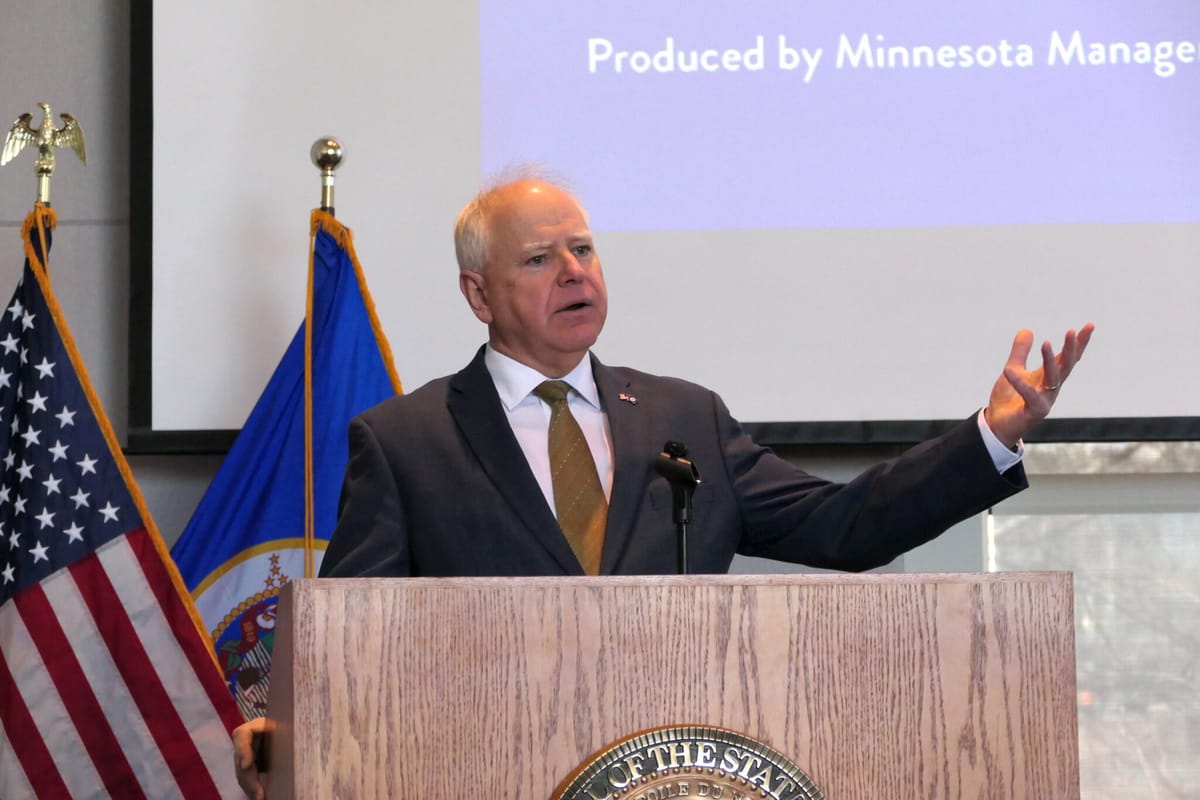Minnesota’s fiscal outlook improves; budget agency urges caution
However, the state still faces a looming deficit — or “structural imbalance” — in future years, as spending will outpace revenue.

By Michelle Griffith, Minnesota Reformer
Minnesota’s budget agency on Thursday said the state’s fiscal outlook has improved since November and now enjoys a $3.7 billion budget surplus, giving legislators more leeway to spend this 2024 session. However, the state still faces a looming deficit — or “structural imbalance” — in future years, as spending will outpace revenue.
Minnesota Management and Budget Commissioner Erin Campbell said the surplus is a $1.3 billion increase from the November projection. This is largely due to more revenue coming in through higher corporate profits and corporate tax revenues.

Beginning in fiscal year 2026, however, the state faces a structural imbalance of nearly $1.5 billion.
MMB says it’s not a “deficit” because they can pay for the structural imbalance with the current surplus.*
The forecast is good news for the state, Campbell said, but she cautioned lawmakers about passing ongoing spending this year.
Here are some takeaways from the February forecast:
Leaders tame spending expectations
Democratic-Farmer-Labor legislators and Gov. Tim Walz have already said they’re going to follow Campbell’s advice. Walz said this session will focus on implementing last year’s ambitious programs, passed when lawmakers approved a two-year budget and spent most of its $17.5 billion budget surplus.
Walz gave muted remarks after MMB’s budget presentation, noting that the findings were positive and Democrats were handling the state’s funds responsibly. But his tone was much less energetic than last year’s February forecast when the state was sitting on a large pile of cash ripe for spending.

(Walz experienced an unsettling night Wednesday — 14 people protesting the Israel-Hamas War were cited for jumping the fence of his temporary home in St. Paul’s Eastcliff mansion. When asked about it, Walz said he doesn’t comment on safety threats against his family.)
House Speaker Melissa Hortman, DFL-Brooklyn Park, on Thursday said lawmakers will be cognizant of the looming structural imbalance during the session.
“We have our eyes on that structural imbalance,” Hortman said. “I do not foresee making any commitments to spending that we can’t afford.”
Still, both Hortman and Senate Majority Leader Erin Murphy, DFL-St. Paul, said they will work to cut the cost of child care, housing and health care for Minnesotans.
Hortman and Murphy said they hadn’t talked to their DFL colleagues about spending priorities in light of the forecast, but Hortman said she’s received a few text messages from people “asking for things.”

Murphy highlighted bills that could receive funding this year, including investing $120 million for emergency medical services statewide and cutting medical debt.
“Those policies that we will see come through the session … are meant to make sure that the economy for the people of Minnesota works for them. That’s our aim,” Murphy said.
Walz said he will release his office’s recommendations for a supplemental budget in a few weeks.
Potential for a $980 million infrastructure package
MMB said Minnesota now has the debt capacity to borrow $980 million in general obligation bonds to fund critical public works projects throughout the state.
Walz earlier this year announced his own $982 million infrastructure package, with about $819 million of it funded through bonds.
Legislative leaders said a capital investment package — colloquially known around the Capitol as a bonding bill because the projects are funded with borrowed money — is one of their top priorities.

Walz said he will consider including more projects in a bonding bill now that the state can borrow more funds, though with an eye toward future interest rates. Hortman said lawmakers will now also consider funding infrastructure projects with cash in light of the budget forecast.
Last year, lawmakers approved a $2.6 billion infrastructure bill after a split Legislature had stalled critical public works spending for two years.
Borrowing money through bonds requires a three-fifths legislative supermajority. Last year, Republicans leveraged their needed votes to advocate for $300 million in additional nursing home funding.
Republican legislative leaders said they want to be included in the infrastructure negotiations, but they declined to say whether they would support another bill this year.
“Even though we are not guaranteeing that there will be a bonding bill, we want to be part of crafting that language in the bill — no wasteful spending in there,” said House Minority Leader Lisa Demuth, R-Cold Spring.

Republicans: Don’t take Dems’ word that they’ll reduce spending
Demuth and Senate Minority Leader Mark Johnson, R-East Grand Forks, said Democrats last year promised to invest the $17.5 billion surplus wisely but broke the promise. The Republican leaders said they’re skeptical that Democrats will rein in spending this session.
“Their rhetoric does not always match the actions and so they’ve got to be fully accountable. That’s our job and we’re going to be working on that as Republicans,” Johnson said.
Demuth said Democrats who promised to eliminate the state’s tax on Social Security benefits have broken their promise. She and Johnson said it’s too late to do so now since the state’s facing a structural imbalance.
“Last year was the year to fix that. We had the money to do it,” Johnson said. “Now (Democrats) have taken that option off the table from us because we no longer have the capacity to do it.”

There’s still an election coming
The November election is looming over the Legislature this session, as all 134 seats of the Minnesota House will be on the ballot. The closely divided 34-33 Senate is not on the ballot, though a special election to replace state Sen. Kelly Morrison, who is running for Congress in the 3rd District, is likely. Legislators are working on bills through the November lens, meaning they’re hoping their constituents will reward their work by granting them another term.
Hortman said she doesn’t think the work they will do this session will have a direct impact on the November election.
“The election has never been about what people think it’s going to be about. So I think what we have to focus on is doing the work that we need to do for the people of Minnesota in a bipartisan way,” Hortman said.
Republicans are already campaigning on the new Minnesota state flag, as well as the costly renovation of the office building that houses the offices for the members of the House.
*Correction: Due to an editing error, a previous version of this article incorrectly characterized how state government would cover any future “structural imbalance.” There would be no need to use budget reserves to cover the imbalance given the current surplus.
Minnesota Reformer is part of States Newsroom, a nonprofit news network supported by grants and a coalition of donors as a 501c(3) public charity. Minnesota Reformer maintains editorial independence. Contact Editor J. Patrick Coolican for questions: info@minnesotareformer.com. Follow Minnesota Reformer on Facebook and Twitter.



Comments ()